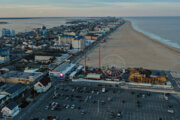Wizards' practice facility surrounded by D.C.'s history and future originally appeared on NBC Sports Washington
WASHINGTON — When Wizards players commute to work each day to the team’s practice facility in Southeast Washington, they drive through the campus of what was formally known as the Government Hospital of the Insane.
That’s just one of its outdated names. It was also referred to on 19th-Century maps as the Government Lunatic Asylum. The main artery that takes you there, now known as Martin Luther King Jr. Ave. SE, was once Asylum Rd.
The sprawling facility was rebranded to St. Elizabeths Hospital and operated across its East and West campuses for over 150 years. A newer structure by the same name still operates, though with far fewer patients. The old buildings, in the design of the Italian Renaissance Revival, still stand as artifacts surrounding the Wizards’ practice facility, most of them abandoned for decades and consumed by nature.
The irony of St. Elizabeths Hospital, the original, is that it was opened in 1855 as an innovative step forward in mental health care. It was shut down as a federal hospital in 1987 in part because it had fallen behind the times.
The Wizards’ facility, which also houses the Washington Mystics, Capital City Go-Go and a calendar full of concerts and other events, has become D.C.’s basketball headquarters. Yet, it is encompassed by scenery reminiscent of the movie ‘Shutter Island’ or the ‘Upside Down’ in the Netflix show ‘Stranger Things.’
POINT OF INTRIGUE
While the buildings are unusual in their style and state, some Wizards players see something familiar in them when they drive by. Corey Kispert is reminded of his high school. Kristaps Porzingis says he’s reminded of Latvia, his home country, where abandoned structures are relatively common.
Deni Avdija, who is from Israel and played professionally across Europe before joining the NBA, had a similar observation.
“It reminds me of Europe kind of structures. It’s like Latvia, Russia, Czech Republic kind of buildings,” Avdija said.
When Porzingis first arrived at the facility in February after being traded to Washington from the Dallas Mavericks, he thought the driver made a mistake.
“Honestly, I thought we were going in the wrong direction,” Porzingis said.
While the players know very little about the history of the buildings, some of them are naturally intrigued. It’s not often anyone encounters these types of relics, especially just steps away from a multi-million dollar NBA practice facility.
“It reminds me of like a haunted house, like a spooky ‘Call of Duty’ map or something,” Kyle Kuzma said. “This is a weird ass place, honestly. That s— creeps me out.”
One member of the Wizards’ organization with some context to offer is front office executive Frank Ross. He grew up just blocks away, on Savannah Pl. SE, and his mother, Lillie Mae, was a psychiatric nurse at St. Elizabeths for nearly 20 years.
Ross used to walk the family dog near the campus as a kid and as a teenager, then living in Maryland, would drive his mother to work at the hospital. The Wizards building their home base in the middle of St. Elizabeths campus was a strange twist of fate for him.
When the Wizards’ facility opened decades later and Ross returned, now as head of their college scouting, he was amazed at how intact the roofs of the buildings are. The red tile looks just the same it did in the 1980s and that’s not the case on the homes near his home in Texas, where similar roofs have faded in the sun.
Ross’ perspective on St. Elizabeths is unique, but also filled with its own gaps. His mother never talked about work and he never went beyond the gates.
“It was kind of eerie because you never saw people out. You saw people go in, the people that worked here,” Ross said. “They never had a take your kid to work day here. I only saw the outside.”
Ross has made a career out of basketball. He starred at American University and was drafted by the Philadelphia 76ers. But he had never noticed one ironic feature of the St. Elizabeths campus. Just one block away from the facility, on Poplar St. SE, is a depleted outdoor basketball court.
None of the players interviewed for this story had seen it, either. Only head coach Wes Unseld Jr. had spotted it on his way to and from work.
“Oh yeah. It’s a short court, obviously in disrepair,” Unseld Jr. said.
Finding out the backstory of that court was not easy.
RICH HISTORY
There is literature available online and in libraries about St. Elizabeths, its history and its significance to the furthering of mental health care. The old campus paralleled and was intertwined with important moments in U.S. history. It is a history that is perhaps underappreciated, like other areas and places of significance east of the Anacostia River. For instance, the Wizards’ facility is just two miles away from Frederick Douglass’ estate.
Historian Sarah Leavitt wrote an all-encompassing book about the original St. Elizabeths Hospital while she was involved in an exhibit at the National Building Museum. Her book, ‘St. Elizabeths in Washington, D.C.: Architecture of an Asylum’ explores the place from the very beginning, how it was originally constructed with the very design of the buildings as integral to patient care. The idea at the time, drawing from the Kirkbride Plan, was that patients could be cured by fresh air, sunlight, farm work and beautiful aesthetics.
“It was a world-class facility for a while,” Leavitt said in a phone conversation.
The hospital was originally federally funded before it was turned over to the District in 1987. It peaked at nearly 8,000 patients and treated upwards of 120,000 patients over time. Today, roughly 300 people – all forensic patients – are cared for at the new building on Alabama Ave. SE.
Plenty of controversy tainted St. Elizabeths during its more than a century of existence on the original campus. It was shut down in part because of de-institutionalization and underfunding but also because of numerous cases of misdiagnosis and inadequate treatment.
Behind the red brick walls housed decades of pseudoscience experiments like conversion therapy, electroshock therapy and lobotomies. It had a deep history of racial segregation. In the early 1940s, marijuana and LSD were tried as truth serums on Nazi war prisoners.
The hospital housed mostly military patients at its inception during the Civil War. President Abraham Lincoln visited Union soldiers who were wounded in combat. Over 200 Civil War soldiers are buried in a cemetery on the West Campus.
Famous poet Ezra Pound was a patient at St. Elizabeths. So were several men who attempted to assassinate presidents: John Hinckley Jr. (Ronald Reagan) and Richard Lawrence (Andrew Jackson).
At its peak, St. Elizabeths operated as a self-contained town. It was self-sufficient for water, power supply, laundry, food sourcing, a fire station and had nearly 4,000 staff members. There were underground tunnels for transport.
Mental health advocate Dorothea Dix was integral in its inception and, for a long time, her vision came true. It was a better place for mental health patients than other institutions in the past. There were advancements in dance, art and recreational therapy and the study of human brains. There was an auditorium for plays, operas and other acts, that hosted shows from artists like John Philip Sousa. There was a zoo with bear cubs for the patients’ entertainment.
Over time, St. Elizabeths became a mystery to Washingtonians. In 1972, Washington Post reporter Karlyn Barker posed as a depressed ex-girlfriend on the brink of self-harm to be admitted as a patient. She spent five days and five nights in the facility and wrote about her experience.
Eventually, as the years went on and federal funding dried up, neglect gave way to complete desertion.
“I think it benefited those neighborhoods for a while, but then it also created this huge hole in those neighborhoods where nothing else could happen,” Leavitt said. “[And] in terms of the streetscape, and the way that the neighborhoods became disconnected from one another, it was problematic.”
MAKING PROGRESS
Nowadays, many of the original buildings around the Wizards’ facility are behind tall fences with boarded or smashed in windows. Red and green ivy slithers up the brick and across caged outdoor staircases.
The plan is to gut and refurbish many of the old buildings and that process has already begun. The center building on the West Campus was converted into an office for the Department of Homeland Security. When those plans were first laid and the site was surveyed, much of the interior belongings of those who were treated there and worked there were still in place — patient beds, papers on desks and clothing.
This October, NBC Sports Washington brought a photographer into Building 100, which was once a mixed dorm for patients. Paint was peeling off the walls. There were animal droppings and beer cans left by vagrants.
Building 100 is one of the next to get a makeover, but that process has already taken place across the street from the Wizards’ facility. Original hospital buildings were renovated to become affordable housing. The brick walls, window bars and roofs were preserved and restored. From inside, you can look out the same windows patients once did and see the Entertainment and Sports Arena.
The practice facility, built with a $69 million construction cost paid for in part by public funding, opened in 2018. It was in partnership with Events D.C., which also operates the Gateway Pavilion nearby, where farmers markets and other events are held, and the R.I.S.E. Demonstration Center, where events such as community meetings on gun violence, weddings and church services take place.
Those three structures have given new life to Ward 8 and Congress Heights, one of the most underserved parts of Washington, D.C. and its surrounding area.
“The Entertainment and Sports Arena is a catalyst for the revitalization of St. Elizabeths East Resilience Campus,” D.C. Deputy Mayor John Falcicchio said. “What was once a vacant, abandoned federal mental health facility in Ward 8 is now the epitome of our comeback.”
“Having the Wizards practice in our community has been a breath of fresh air,” Ward 8 Councilmember Trayon White Sr. added.
What was once a parking lot adjacent to the arena is now a fast-moving construction project set to host restaurant and retail space in a matter of months. There are plans to raze the St. Elizabeths Hospital buildings behind the lot to build a town center connecting the Congress Heights metro stop to the stadium.
Fans attending Mystics and Go-Go games, and concerts and other events will have more reason to show up early and stick around afterward.
“It is something that the neighborhood can be proud of and ultimately will be an incredible part of Washington, D.C.,” Ralph Morton, Senior Vice President of Events D.C., said.
“As we book more and more events at the Entertainment and Sports Arena, we’re bringing new people down to the neighborhood. We’re bringing a different type of vitality many days a week with all kinds of events where it’s making more and more a place to be.”
The development of the St. Elizabeths Hospital campus could follow the track of other areas of the city. Though, it’s unique in the sense the buildings immediately surrounding the Wizards’ facility are unoccupied. They are essentially starting from scratch, but with an historic outline to operate with.
One neighborhood in D.C. that could serve as precedent is Chinatown, where the Wizards and Capitals play their home games at Capital One Arena. When the arena was opened as the MCI Center in 1997, it was not the commerce and tourist hub it is today.
Unseld Jr. remembers that time well. During his first stint with the franchise, when his father was still working for the organization, Unseld Jr. served in the front office and as an assistant on the coaching staff. The building was both their home arena and their practice location.
“It was a place you went to work and then went home,” Unseld Jr. said. “It’s changed. A lot of that area was probably underserved for a long time and neglected until they decided to put that building down there and it kind of pulled it back and it’s brought it back to life a little bit.”
Having seen the transformation of that part of the city, Unseld Jr. knows the potential impact the Entertainment and Sports Arena could have on Ward 8. He’s amazed at the sheer acreage of land that has remained unused for decades.
Many Wizards players share the same sentiment and hopes for a revival. Star guard Bradley Beal mentioned his intent to help the citizens in the surrounding area during a press conference last February, when asked about his free agent future in Washington.
“It is amazing to see what Ward 8 is going to do around here, what all of St. Elizabeths East is going to turn into,” Beal said.
“But I really hope that we have a big part in influencing that the people of Ward 8 are able to get these jobs, to be able to live in these homes; these nice townhomes that are being built over here… it’s great to have a facility here, but let’s help them.”
THE BASKETBALL COURT
The outdoor court on Poplar St. has gone unnoticed by Wizards players, yet it has symbolism as a place where basketball was once played decades ago, just one block away from where the sport is played at its highest level today. The Mystics won an WNBA championship at ESA. Last fall, Duke and Villanova scrimmaged on the Wizards’ practice court. Beal, Porzingis, Elena Delle Donne, Russell Westbrook, Dwight Howard, Stephen Curry, Kevin Durant, Klay Thompson are among those who have shot on its rims.
So, who played on the outdoor court? According to Latrena Owens, the Director of St. Elizabeths East, it was used by patients as part of their recreational therapy. Now it sits in a courtyard of lush greenery and vines. The rims are still intact, though one backboard leans to the right. The free throw lines on the court remain.
When Building 100 is turned into something else, so will the space on which the court now resides, as the city finally turns the page on the area, decades after it was left for ruin.







